Are you a Quiet Speculation member?
If not, now is a perfect time to join up! Our powerful tools, breaking-news analysis, and exclusive Discord channel will make sure you stay up to date and ahead of the curve.
Actual comments from my previous article, “A Defense of the Splinter Twin Ban:"
"As someone who has played around extensively with a variety of URx decks, I can tell you that in the past four years or so, Twin is the only one I’ve found viable not because the Twin package is so enticing, but because it’s the only way to build URx that isn’t below the bar for viability in the format.”
"Why – they were best when Twin was in the format due to the great matchup they had – the idea that RUG Delver is now somehow good is fanciful."
"Temur Grow is now sh*t as twin is not in the format – same with most blue decks."
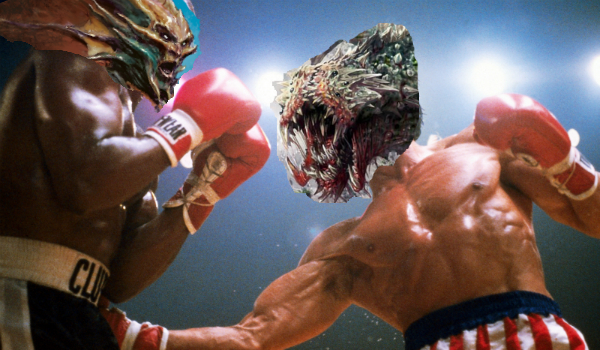
Two days after that article went public, StarCityGames released the Top 16 results from their Atlanta Classic Modern tournament. Temur Delver took 1st place. It also took 10th place. I love saying “I told you so” as much as the next guy, but the real joy in these results came from the affirmation that a deck I helped create has a shot at the title in my favorite format.
It’s like Rocky VIII. Starring Tarmogoyf. (Rated R.)
In this article, I’ll compare Todd Anderson’s and Brandon Gaudet’s winning decklists to my own, analyze their choices, and contemplate possible builds in a shifting metagame.
[wp_ad_camp_1]
Speaking of Classic...
Here's my current Temur Delver list:
Monkey Grow, by Jordan Boisvert
Build Notes
This version looks a lot like my last Monkey Grow build, mostly because I've worked enough with the shell to optimize the deck. Tuning usually takes the form of minimal tweaks. Since the Twin ban, I've cut the third Simic Charm for a Spell Snare, and the mainboard 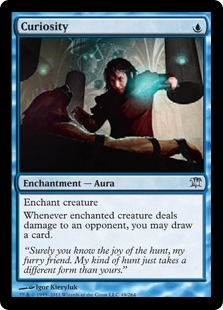 Curiosity for Snapcaster Mage.
Curiosity for Snapcaster Mage.
Curiosity shines against linear combo and midrange strategies, but as BGx ebbs with the rise of linear aggro and Eldrazi, it becomes more of a liability in the main. Similarly, Simic Charm makes us feel invincible if we untap with a threat; unfortunately, it's too slow for a format this linear. I can see Charm creeping back up in number as interactive decks figure out how to police the format and people start playing Abrupt Decay again. For now, I'd rather have Spell Snare, which acts like Disrupting Shoal #5 against most Modern decks.
My comparisons of Anderson's and Gaudet's lists to this one won't do you any good without an understanding of Exhibit A. For anyone unfamiliar with Monkey Grow, or URx Delver decks in Modern since the Treasure Cruise ban, I recommend the following articles:
- Welcome to the Jungle: Mandrills in Modern
- Shoal Food: Grits and Goyfs at GP Charlotte
- Curious George Goes to a Super Series: Revisiting Monkey Grow, Chapter 1
- Curious George Goes to a Super Series: Revisiting Monkey Grow, Chapter 2
Scrutinizing Shoal
I've extolled Disrupting Shoal's strength in Modern grow decks since last year. But Todd Anderson and Brandon Gaudet omitted the card from their Atlanta-smashing lists. This section explores Shoal's function in grow and explains its sustained inclusion in my builds.
Disrupting Shoal and Curving
Delver decks don't play many lands. Most players new to the archetype, and I assume many ex-Twin players sniffing around for something to do with their Snapcaster Mages, probably don't think Delver decks play enough lands. In any case, 17 lands aren't enough to support a playset of the homeless Wizard.
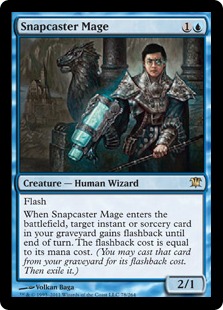 The most obvious way to enable Snapcaster Mage in multiples is to increase the deck's land count. Anderson ran a whopping 20 to ensure his four flash friends came online constantly. Equally obvious is the effect more lands have on the deck's namesake creature. Adding lands incentivizes deckbuilders to add Snapcaster Mages, as well. As lands and creatures cut into the deck's numbers, Delver himself eventually becomes unplayable. We saw this scenario play out to its logical extreme last summer, when Grixis Delver players dubbed the Insect-in-disguise "the worst card in the deck" and almost universally transitioned to Grixis Control.
The most obvious way to enable Snapcaster Mage in multiples is to increase the deck's land count. Anderson ran a whopping 20 to ensure his four flash friends came online constantly. Equally obvious is the effect more lands have on the deck's namesake creature. Adding lands incentivizes deckbuilders to add Snapcaster Mages, as well. As lands and creatures cut into the deck's numbers, Delver himself eventually becomes unplayable. We saw this scenario play out to its logical extreme last summer, when Grixis Delver players dubbed the Insect-in-disguise "the worst card in the deck" and almost universally transitioned to Grixis Control.
Of course, Anderson and Gaudet never got that far, and they both reaped the benefits of maintaining a grow strategy in the current (admittedly, fickle) metagame. But there's a way to play more two-drops without watering down the deck's spell suite. Disrupting Shoal turns those "clunky" Snapcaster Mages into free Spell Snares. The same applies to Simic Charm and Mana Leak. Without Shoals, I could never dream of running so many expensive spells in my build.
Commit, then Disrupt - Why Not Both?
Just as midrange decks disrupt opponents, then commit threats, tempo decks commit first, then disrupt. Disrupting Shoal breaks the fundamental rule of Modern tempo that doesn’t allow us to interact as we commit our threats.
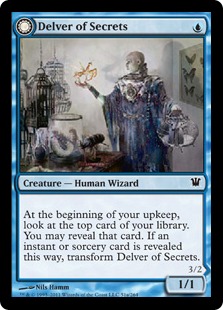 Consider Todd Anderson’s Temur Delver deck, below. Anderson commits threats first, casting Delver of Secrets on turn one and maybe Tarmogoyf on turn two. If opponents haven't removed these threats, he holds up Remand and attacks with the pressure he’s established. Assuming he makes every land drop, on turn four, he enters the phase of the game where he can reliably commit threats and disrupt opponents at the same time. Anderson can play Goyf and hold up Remand. Or tap out for Snap-Remand.
Consider Todd Anderson’s Temur Delver deck, below. Anderson commits threats first, casting Delver of Secrets on turn one and maybe Tarmogoyf on turn two. If opponents haven't removed these threats, he holds up Remand and attacks with the pressure he’s established. Assuming he makes every land drop, on turn four, he enters the phase of the game where he can reliably commit threats and disrupt opponents at the same time. Anderson can play Goyf and hold up Remand. Or tap out for Snap-Remand.
Sometimes, Anderson’s deck performs better than in my above example. He could play Delver turn one, another Delver and a Spell Pierce turn two, and a third Delver plus a Remand turn three. In this scenario, Anderson has interacted and committed threats - the late-game standard for any Modern tempo deck - on turns two and three. But what if his opponent played a turn one Grim Lavamancer?
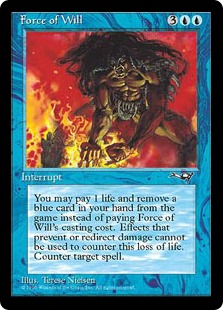 Delver is so powerful in Legacy because in that format, the deck achieves this standard on the first turn. Pilots can lead with a Delver, then Daze or Force of Will their opponent’s first-turn spell. If that spell is a Lightning Bolt, the Delver pilot saves himself some grief. Modern Delver players have to tap out for Tarmogoyf to recover from such a situation, leaving them at the mercy of their opponent’s next play. Unlike Twin, Delver can’t afford to simply hold up Remand with an empty board, since almost every other deck in the format has more inevitability than a Delver deck without a threat.
Delver is so powerful in Legacy because in that format, the deck achieves this standard on the first turn. Pilots can lead with a Delver, then Daze or Force of Will their opponent’s first-turn spell. If that spell is a Lightning Bolt, the Delver pilot saves himself some grief. Modern Delver players have to tap out for Tarmogoyf to recover from such a situation, leaving them at the mercy of their opponent’s next play. Unlike Twin, Delver can’t afford to simply hold up Remand with an empty board, since almost every other deck in the format has more inevitability than a Delver deck without a threat.
Disrupting Shoal allows Modern Delver decks to commit threats and counter spells at the same time, and as early as the first turn. I only play one- and two-cost blue spells to exile with Shoal because by the time opponents get to three mana, I want to be attacking with Mana Leak up. In a metagame full of linear decks such as Atlanta’s, and in this Bolt-heavy format in general, I would not want to register a Temur Delver list without Disrupting Shoal.
Shoal's Absence from Atlanta
So why didn't Anderson and Gaudet play Shoal themselves? I think they lack experience with the card. When I won a Worcester IQ with Temur Delver, a number of pros streamed my deck on their sites. Most of them had no idea what to do with Shoal, and boarded it out at the first opportunity (or wrongly kept it in). Sometimes, the correct choice isn't the intuitive one - take the success I've had with 3-4 sideboard Huntmaster of the Fells in a 17-land deck. But these important, less intuitive cards often get axed first by archetype newcomers. It comes as little surprise to me that Joshua Yang Zhijian’s build, which Top 8’d GP Singapore last year, played just two copies of Disrupting Shoal. Or that the Atlanta lists follow in Patrick Dickmann’s footsteps and forego Shoal altogether.
A chat with Dickmann confirms my hunch. I'll quote him directly:
"I did not test Shoal because I thought that Stubborn Denial was just better [...] I countered countless Karns and Ugins which were out of Mana Leak reach and it was also impressive against most spell based decks. However, due to the deck only having 17 lands, I sometimes was not able to deploy threats and keep up enough counters at the same time. In those spots, Disrupting Shoal could be good, maybe even in the spot of Mana Leak (often felt clunky but felt like a necessary evil). Would be nice to have something that counters all those pesky maindeck and sideboard Relics. Unfortunately, I'm a guy who likes himself some value so I'm turned off by card disadvantage, although I can see the card being good in a heavy affinity/infect/combo meta."
The jury's still out on Gaudet, but Anderson's recent StarCityGames Premium article reveals that he built the deck out of fun-looking cards in his Modern box and didn't do any testing. Dickmann and Anderson both cite Temur Delver's inconsistency as its primary detractor, and Shoal helps immensely with that aspect. If the deck catches on, and players spend enough time with it, we should see Shoal again.
1st Place: Todd Anderson
Anderson's winning decklist reads like an Intervention episode on Splinter Twin withdrawals, boasting full sets of Snapcaster Mage and Remand, 20 lands, and Young Pyromancer, a standby from the Tier 1 Delver decks of old.
Temur Delver, by Todd Anderson
Twin Envy
Nothing gives a mourning Twin enthusiast away like four Snap, four Remand. Some Googling vindicates my suspicion. Anderson played TarmoTwin to five impressive finishes last year, and has rocked out with Deceiver Exarch since its Standard debut.
The Snap-Remand suite won Anderson countless Modern tournaments in 2015, so I can understand his reluctance to part with it. But without Twin in Modern, it loses points. Remand excels against big mana decks like Tron and versus grindy counterspell strategies. Temur Delver already sweeps Tron, and I don't know of a viable blue midrange deck right now. Remand is also only valuable here when the deck establishes board advantage, and a flawless opposing defense of Bolt-Terminate-Liliana will keep that from ever happening. Anderson's article acknowledges the weirdness of Remand in this deck, admitting, "I have never seen a card be so great and so terrible at the same time." Given his light Ape count and subsequent abandonment of Stubborn Denial, I think the card was more useful to Anderson against, say, Karn decks than it is to traditional builds of Monkey Grow.
But without Twin in Modern, it loses points. Remand excels against big mana decks like Tron and versus grindy counterspell strategies. Temur Delver already sweeps Tron, and I don't know of a viable blue midrange deck right now. Remand is also only valuable here when the deck establishes board advantage, and a flawless opposing defense of Bolt-Terminate-Liliana will keep that from ever happening. Anderson's article acknowledges the weirdness of Remand in this deck, admitting, "I have never seen a card be so great and so terrible at the same time." Given his light Ape count and subsequent abandonment of Stubborn Denial, I think the card was more useful to Anderson against, say, Karn decks than it is to traditional builds of Monkey Grow.
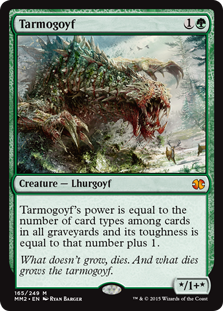 Snap-Remand aside, this deck doesn't forsake its tempo roots. The inclusion of triple Vapor Snag, triple Spell Pierce harken back to Delver's own Standard beginnings, when Anderson swore by UW Delver. With the lack of Shoals and Snares, Vapor Snag clears the way of enemy Tarmogoyfs. Pierce has always been criminally underplayed in Modern, which adds to its potential. An unexpected Pierce frequently provides massive blowouts. Additionally, playing Pierce in a four-Snapcaster deck puts opponents on edge when a copy sits in the graveyard. It must have been refreshing for Anderson to at least partially replicate Twin's marquee fear with this combination, and I don't doubt he stole some tempo from opponents who neglected to tap out for an otherwise timely Kolaghan's Command.
Snap-Remand aside, this deck doesn't forsake its tempo roots. The inclusion of triple Vapor Snag, triple Spell Pierce harken back to Delver's own Standard beginnings, when Anderson swore by UW Delver. With the lack of Shoals and Snares, Vapor Snag clears the way of enemy Tarmogoyfs. Pierce has always been criminally underplayed in Modern, which adds to its potential. An unexpected Pierce frequently provides massive blowouts. Additionally, playing Pierce in a four-Snapcaster deck puts opponents on edge when a copy sits in the graveyard. It must have been refreshing for Anderson to at least partially replicate Twin's marquee fear with this combination, and I don't doubt he stole some tempo from opponents who neglected to tap out for an otherwise timely Kolaghan's Command.
Anderson's Hooting Mandrills aren't the same second-turn beaters from Monkey Grow. They only show up twice here, with a lonely Thought Scour to back them up. Anderson wants to cast them "incidentally," filling his graveyard by playing interactive Magic.
Mainboard Tech
 Young Pyromancer: If opponents see this guy, they almost always board in their toughness-conditional sweepers. Electrickery, Pyroclasm, Kozilek's Return, and Flaying Tendrils don't put a huge dent in Anderson's plan. In fact, he probably benefits from opponents boarding them in. The singleton Pyromancer baits out these "bad" cards. It also allows Anderson to play a decent midrange game against aggro decks, providing incremental advantage (and endless chump blockers) just for casting cantrips.
Young Pyromancer: If opponents see this guy, they almost always board in their toughness-conditional sweepers. Electrickery, Pyroclasm, Kozilek's Return, and Flaying Tendrils don't put a huge dent in Anderson's plan. In fact, he probably benefits from opponents boarding them in. The singleton Pyromancer baits out these "bad" cards. It also allows Anderson to play a decent midrange game against aggro decks, providing incremental advantage (and endless chump blockers) just for casting cantrips.
Izzet Charm: Superior to Simic Charm in highly linear metagames, since it snipes Glistener Elf and friends or counters Goryo's Vengeance. Mode two seems over-redundant with all the Pierces. I like that Izzet Charm cycles spare lands in the mid-game, though.
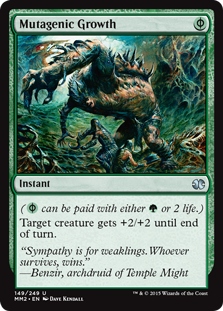 Mutagenic Growth: Saves Insectile Aberration from Lightning Bolt and wins Goyf wars. Growth will never protect Pyromancer or Snapcaster Mage from three damage, and I don't think it does enough in this build.
Mutagenic Growth: Saves Insectile Aberration from Lightning Bolt and wins Goyf wars. Growth will never protect Pyromancer or Snapcaster Mage from three damage, and I don't think it does enough in this build.
Dismember: Catch-all removal is never bad in a format as reliant on creatures as Modern. I believe most blue decks with decent Burn matchups should play some number of Gitaxian Probe, and nonblue decks that beat Burn should consider Dismember. But Anderson only plays three Probes. He should max out on those before splashing Dismember in the main, since the removal spell proves so taxing against linear aggro decks.
Sideboard Tech
Grim Lavamancer: With only two Mandrills in the main, Lavamancer has a lot of juice to gun down creatures with. Great choice in a Monkey-light build.
Spreading Seas: The big talking point from Anderson's sideboard is his choice to run Spreading Seas over Blood Moon. Moon interacts more efficiently, cutting big mana decks off their sources for a whole game and letting the Delver player do “real" things with his mana. That said, Anderson plays enough lands to comfortably cast multiple Spreading Seas during a game, and the Tron matchup is probably already tough to lose. Seas punishes opponents for fetching around Blood Moon, taking a key shock land and leaving them with silly basics. It also resists answers better. Even if it eats a Nature's Claim, Seas already replaced itself and charged its caster less mana than a Moon would have. No Shoal, Denial, or Mandrills 3-4 also makes Anderson's build softer to Burn than mine, and Seas heavily disrupts that deck. I think Moon is better in Temur Delver decks, but expect Spreading Seas to be a real player in the new metagame as interactive decks begin springing up and big mana takes a stranglehold on the format.
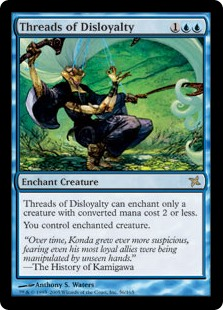 Threads of Disloyalty: An elegant answer to Tarmogoyf with so few Abrupt Decays in the room. Threads also wrestles with Delver, Pyromancer, and even Snapcaster Mage for enemy Decays, “overloading” relevant removal and coming down after a lengthy card exchange to turn the tables on the Jund player who thought he had the last laugh.
Threads of Disloyalty: An elegant answer to Tarmogoyf with so few Abrupt Decays in the room. Threads also wrestles with Delver, Pyromancer, and even Snapcaster Mage for enemy Decays, “overloading” relevant removal and coming down after a lengthy card exchange to turn the tables on the Jund player who thought he had the last laugh.
Gut Shot: A fine choice against an expected field of linear aggro. Wrecks Affinity or Infect players going “all-in” on their tapped out opponents. I would prefer Forked Bolt here, but Gut Shot can make some unique plays (i.e. hit a Wandering Fumarole).
Surgical Extraction: Turns the already favorable Grishoalbrand matchup into a bye, and has random game against a few other strategies. But overall, I don’t think Surgical Extraction earns its place here. Mainboard Shoal and Denial address the rarely-seen Grishoalbrand more reliably, as well as the other obstacles Anderson encountered with the deck.
10th Place: Brandon Gaudet
Gaudet kept things low-to-the-ground with a pair of Monastery Swiftspear. He also inexplicably (and hilariously) "lost" his fourth Tarmogoyf.
Temur Delver, by Brandon Gaudet
How Low Can You Go?
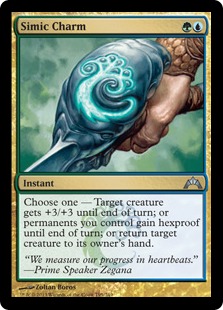 Gaudet’s also a former TarmoTwin player. We still tread familiar waters with his deck, which looks like an updated Monkey Grow. Like Anderson, he skipped Disrupting Shoal, instead packing Spell Snare to interact early and Vapor Snag to eliminate threats that squeeze past permission. This extra removal makes Monastery Swiftspear less of a liability against creature decks, where it sometimes has trouble getting in damage.
Gaudet’s also a former TarmoTwin player. We still tread familiar waters with his deck, which looks like an updated Monkey Grow. Like Anderson, he skipped Disrupting Shoal, instead packing Spell Snare to interact early and Vapor Snag to eliminate threats that squeeze past permission. This extra removal makes Monastery Swiftspear less of a liability against creature decks, where it sometimes has trouble getting in damage.
Lightweight ground threats devastate linear metagames. Atlanta’s certainly qualifies, and the tournament’s top tables speak to this rule. Both Burn decks in the Top 16 maxed out on Wild Nacatl. UG Infect reminded us it exists, and Burning-Tree Zoo popped up twice. I don't have the numbers on hand, but Tron apparently had strong showings at this event. Gaudet’s Swiftspears probably had few problems connecting in this linear field, meaning he essentially got to play six Delvers.
Mainboard Tech
Forked Bolt: A hedge against Infect, Hierarch decks, and Delver mirrors. Also hits Lingering Souls tokens from BW Eldrazi. As far as "extra Bolts" go, Forked Bolt looks very attractive right now. Tarfire loses value with Tasigur and Siege Rhino out of the picture.
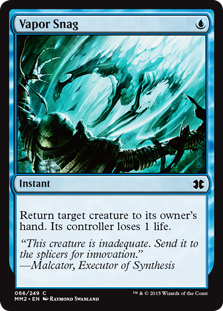 Vapor Snag: Passable over more Simic Charms with Swiftspear, who demands Gaudet keep the ground clear at all times.
Vapor Snag: Passable over more Simic Charms with Swiftspear, who demands Gaudet keep the ground clear at all times.
Spell Snare: Counters Tarmogoyf. At just one mana, Snare also helps Gaudet interact in the early game while deploying threats.
Remand: Gaudet probably wants to increase Snapcaster flexibility with this one-off, but it seems strange to me in a deck so concerned with playing spells in its main phase.
Wooded Foothills: Gaudet's manabase is identical to mine, except he registered a second Foothills over his fourth Scalding Tarn. Maybe he's “pulling a Tarmogoyf,” but the second Foothills does help Blood Moon from the board come down on turn three without cutting him off green. Playing two Foothills and three Tarns could be correct against an expected field of big mana.
Sideboard Tech
Vendilion Clique: It's no secret that Clique terrorizes combo players. It also surprise-trades with threats from an aggro deck in combat, or flies over board stalls for those same matchups. Clique has been tremendous for me against Eldrazi decks, and I like the card more as the metagame continues its shift away from Lightning Bolt.
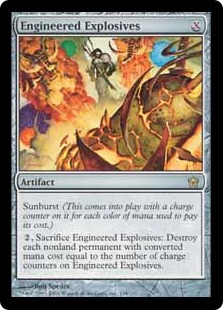 Engineered Explosives: A catch-all answer to fatties like Tarmogoyf and Scavenging Ooze, random bullets like Ensnaring Bridge and Chalice of the Void, or just a swarm of tokens. With Twin gone, and 1-3 CMC permanent decks picking up steam in Modern, the card is poised for a comeback.
Engineered Explosives: A catch-all answer to fatties like Tarmogoyf and Scavenging Ooze, random bullets like Ensnaring Bridge and Chalice of the Void, or just a swarm of tokens. With Twin gone, and 1-3 CMC permanent decks picking up steam in Modern, the card is poised for a comeback.
Roast: More answers for ground creatures, but I'm not sure what Gaudet expected to kill with these. Maybe other Goyfs. Maybe he just expected some Grixis players. I think Flame Slash is better right now.
Underdog Fighter: The Other Delvers
While Temur isn’t the only Delver deck in Modern, Tarmogoyf makes the wedge so adaptable that it’s hard to argue with its dominance in such an open field. UR Delver stands to benefit from the Twin ban, but it won’t hold a candle to Temur. Grixis never even had a chance.
I still haven’t stopped tuning my other Delver decks. Interactive decks will pop up once the metagame settles, and big mana should follow in its footsteps. When that happens, depending on how slow Modern becomes, iGrow may be extremely well-positioned.
Oath of the Gatewatch gave the deck an adrenaline injection in Stormchaser Mage, a two-drop that keeps us in two colors, flies over 5/8s, pitches to Disrupting Shoal, and all but guarantees lethal after Day's Undoing. This upgrade also makes the deck more affordable, and Brandon Gaudet can play it without digging up that fourth Tarmogoyf!
iGrow, by Jordan Boisvert
iGrow can’t be played at higher levels in such a linear field, at least not with Undoing in the main. But I’ll keep my eyes open for a metagame window to reaffirm its potential.
We Come In Peace
Anderson and Gaudet brought "unfinished" decks to Atlanta, and it's possible they simply lucked out last weekend. Temur Delver may, as Anderson predicts in his SCG article, soon be phased out by Modern players. But I doubt it. In my eyes, the SCG Atlanta Classic foreshadows a format where the iconic 3/2 finally gets a promotion from cadet to officer.
Shifting metagames perfectly showcase the worth of brutal efficiency. Modern always corrects itself, making the re-establishment of sturdy policing decks a matter of "when" and not "if." Until that happens, Delver enthusiasts want Lightning Bolt and Tarmogoyf to reign in the linear onslaught.
That means nothing but green guys. Forget Rocky VIII - it’s Mars Attacks!




there are monastery mentors in that igrow list at the end, with zero white sources. Correct the error please, whatever it happens to be. I presume it’s supposed to be monastery swiftspears.
Error corrected. No idea how all three of us missed that! Sorry for the error.
Well, if I’d known you were going to quote me in an article, maybe I would have been more precise in my wording. I think of the bar for viability above “could win an SCG side event” and more like “this deck can and will reasonably top 32 multiple GPs, PTs, or SCG opens.” Otherwise we have to accept any deck with a proactive gameplan as viable, when clearly some (Affinity, Infect) are very good and some (Treefolk, Puresteel Paladin combo) are mediocre.
One way or another my point was that Twin was taking up URx shares because the other decks are soft, not because Twin itself was something so ahead of the curve or that was so appealing in itself that it was invalidating alternatives.
If we see RUG Delver or Blue Moon or Grixis Control or UWR Kiki or some other decks perform at the PT, or especially the PT and a subsequent GP, I’ll certainly cede the point though. Things change, and I’m willing to be wrong. Those decks have things to recommend them, but ultimately their weaknesses (slow, inconsistent, underpowered, etc. depending on which one you look at) make them things I wouldn’t want to bring to a GP I wanted to cash, whereas decks like Jund, Affinity, probably Tron or Infect in the new metagame are all things I would be interested in playing because they’re just a higher caliber of deck.
Time will tell!
‘Told you so’ – pfft deck is still sh*t and even Todd said so – perhaps you should do some reading..You know what else got in the top 8 of these minor SCG tournaments since 22 January
Four-Color Gifts
W/R Control
Puresteel Paladin
I think its great that you like brewing etc – but at least admit that the power level is mediocre – dont carry on as if it is going to break modern
Weird that these “sh*tty” decks are still winning IQs!
http://sales.starcitygames.com//deckdatabase/displaydeck.php?DeckID=98269
I know you had that win at a 5k, but I’ll take the collective testing and wisdom of many more players with many more good results when it comes to talking about Shoal. Your articles on Delver are almost insightful, but spend way more time trying to brag about a single big result and talk trash about how no one else knows anything about the deck or playing Magic most of the time.
Anderson and Dickmann are phenomenal players and deckbuilders, but both admitted to not having tested Shoal. I just think they’d change their minds if they gave it a go. I’m not “better” than anyone; this article is just one Delver player’s opinion of some other players’ Delver lists.
You’re being overly dramatical in your opening passage. Just like you skewed the Twin bannings statistics by comparing it to Pod in your last article (that actually rewards a comment of its own but I hope this is not a trend you’ll be taking) you’re trying to be sensationalist here.
RUG Delver is and was the definition of a Tier 2 deck. It is easily “hated out” by fair strategies in the format (Grixis, Jund, Junk) and has plenty of bad matchups among the popular decks. I talked to Todd myself and he agrees that RUG Delver is not a staple deck in modern and won’t be unless something new radical is printed.
1. There is nothing to RUG Delver in modern that can let it be tier 1 for a longer period of time like in legacy, there are simply none of the tools. In the end all of your beaters are easily answered by any strategy expecting creatures and you cant answer your opponents effectively enough. I know you’re trying to make Shoal viable, but it’s not. We must use Spreading Seas instead of Wasteland and Spell Pierce instead of Daze. Even with those spells Legacy RUG Delver would actually be beaten by Modern Jund/Junk (trust me I’ve done this matchup plenty of times, for fun).
2. The run Todd had at SCG last weekend can be explained by looking at his sideboard and at the amount of linear aggro creature decks at the event. He pretty much has 75 cards against all the linear aggro decks. There is some heavy skewing. He was well prepared for them and he got lucky that he didn’t run into Jund or anything like it.
3. RUG Delver already spiked a few tournaments before the Twin ban, and I would say it had higher chances of doing so since Twin was a better matchup.
4. Point remains that there is not a single Tier 1 blue deck in the format now. UWR Kiki is the natural contender but Tron is an unfavorable matchup and most of the other are even at best, with the linear combo decks being unfavorable. It’s not “too early”, there are simply not enough tools. I know we play Magic but that doesn’t make us “Magicians” that can make any wish happen.
Well, I certainly won’t force you to play RUG Delver! But I’m excited about the deck moving forward. Also, are you sure you know what Tiers are? “Tier 1” means a deck occupies a certain percentage of the metagame. There are no “Tier” decks right now in any color because we simply don’t have the data to make those kinds of calls (but we will soon!).
I think Merfolk will be that tier 1 deck – it went to tier 1 last year and seems to be by default the best blue deck in modern. However, Im willing to accept the argument that Merfolk is blue only due to mana symbols printed in the corner of the card..
I liked the allusion to Rocky Balboa here, although I fear that this type of writing lives on the edge of sensationalism (trying to hype the deck or certain cards) and honest evaluation. There are bits of both mixed in. Going to pick this deck up for myself and do some testing before I cry foul, however. This deck has my name written all over it.
Thanks for this comment. Sensationalism is something I see all over Magic writing and strive to avoid myself. I thought the Rocky jokes were funny enough to include, and didn’t mean to hype anything. After all, the cards I advocate for Delver decks in this article are the same ones I’ve stood by since the Treasure Cruise ban. Have fun testing!
Wow a bold claim to say that you helped invent a deck that has been around since the birth of the format ( it was essentially one of the decks everyone attempted to port from legacy to modern). I will give you the honorary of public champion of the strategy as you advocate it in mtgsalvation forums as well as your articles.
Shoal again is no panacea potion for U based tempo in modern. It is just far to unreliable and decay is still every where. The card disadvantage is far more painful in modern with no real card advantage available to make up for it. Also the cost equivalency clause means that often you need to be more reactive than proactive with cards in hand or you run the very real risk of not having the appropriate cc U spell to protect your threats. One of the worst feelings is Ive had in modern is pitching 2 for 1ing myself end of turn just for the opponent to decay my threat when they untap. That is alot of card disadvantage. Its a win more card as its only really strong in match ups RUG delver is already favoured in; and functionality dead in the match ups you would need the protection in. Cheap hexproof effects are simply better.
Days undoing is unplayable in modern. Sorry but it just is; every time ive cast it against anything but the most narrow of combo decks it has lead to unwinable board state for me when I untap. Unless affinity and burn are banned out of the format I dont see it being playable.
I tend to disagree. Here is what I learned since I started playing them in countercat.
1. This card is very-skill intensive.
I misplayed a lot early on (and still do sometimes). The trick I found to improve this flaw is to study your matchups and figure out which are the critical plays at each stage of the game that need to be countered in order to maintain your tempo/advantage. Once you have that figured out, you can pan out your game plan accordingly.
When played correctly, the tempo you gain/maintain by countering a critical 1-CC or 2-CC spell in many matchups is well worth the card disadvantage. I even pitched a serum visions to protect my T-1 delver and still won without problems.
Afterward, if the cards you were holding back to protect your tempo are no longer needed, they are still useful in their own right. (Cantrip, multi-mode spells, etc.)
2. The deck must be built accordingly to take advantage of shoal’s power.
The red and green shoals have shown us their power when figured out (And one got the ban for it) with decks built to exploit them. Disrupting shoal is not a combo enabler, but it is still a very flexible counterspell when put in the right deck. Study closely Jordan’s iGrow and Countercat decks. See and analyze the critical mass of blue spells in the 1 and 2 CC department. There is a reason behind that.
3. The threat of the “free” counterspell
Believe me that I got many opponents that were forced to adapt their game plan because of the threat shoal represents to their attempts to interact with me, even during their first turn on the play. This by itself is tempo gain for me.
Conclusion : Before dismissing that card so easily, play with it, figure out how to best play it in any relevant situations. Use Jordan’s decks as starting point. Maybe you will change your mind when you will reach a point when you begin seeing despair of your opponents who found out they are in deep trouble after you shoaled the critical spell they needed to break your tempo.
If a pro tour player would be willing to invest the time he needed to master it, I wouldnt be surprised seeing him make a great reccord in the constructed portion of the Pro Tour.
In the igrow list plz -2 sleight of hand +2 twisted image. Baaaad cantrip
Nice, you gave Dickmann credit for the list he carbon copied from the 5-0 finish I posted a week before. Youre a swell guy.
” I love saying “I told you so” as much as the next guy, but the real joy in these results came from the affirmation that a deck I helped create has a shot at the title in my favorite format.”
Wow, i had no idea you invented the whole RUG Delver genre!…
I get as annoyed by Jordan’s ego as the next person, but to be fair to him – his SCG result was the one that put the deck back on the map. In addition he was the one putting the work in on MTGS – so it’s not like he just picked up someone else’s deck, won an event and claimed it as his own. There is enough of Jordan’s work for it to be considered his own.
That said – perhaps take this as a bit of constructive criticism – Jordan you really could do with being a little less self-congratulatory in your articles. You can take that however you want.
Big fan of this kind of criticism. Noted 🙂
I’m always happy when I see a new article about Monkey Grow! =)
I am not sure why a lot of people dislike your articles. I like it when people say their opinions and you have to be sure of what you are saying to present it as your opinion. Thanks for that!
You have inspired me to play the deck and I think it is very good. I just have problems with the Eldrazi deck espetially with Lingering Souls combined with bigger threats and relics. The only way i seem to have a chance is getting delver have it survive and land blood moon. How has the matchup been for you? How do you board? Whats your strategie?
Eldrazi is a serious pain for Temur Delver. Relic is really annoying. Keep in Shoals to stop those (and Maps!) and try to be an aggro deck. If you’re seeing a lot of Eldrazi, consider 1-2 Cliques in the sideboard (extra Delvers!) and maybe some Spreading Seas to supplement Blood Moon.
So how exactly are you going to flip Delver without good cantrips?
I always just cross my fingers and hope it works out. So did Todd and Brandon, and apparently this IQ winner from a few days ago:
http://sales.starcitygames.com//deckdatabase/displaydeck.php?DeckID=98269
Underestimate Temur Delver at your own peril! Even untuned versions of the deck, like this copy of Anderson’s list, are showing great promise in the new format.
A lot of people take this article really seriously.
I think it’s very interesting to see a Delver player testing with a potentially very powerful but hyper underused card in modern. Shoal and Day’s Undoing both fall under that category.
Would love to see a MTGO video of you playing through 4-5 matches with the deck.
The idea is nice but more importantly, seeing the thought process behind something like a Shoal delver deck where every card and mana is very important for both killing the opponent and disrupting them.
I hear the interest in video streaming, but it’s not something I’ve ever done, so it kind of intimidates me. All the streams I’ve tried to watch have been so boring that I’ve just turned them off a couple minutes in. I prefer writing tournament reports, which tend to be quite detailed. That said, if the interest persists, I’ll definitely look into streaming some games.
In the meantime, check out this recent report from a Super Series, which provides reasoning for plays so in-depth we had to split the article into two pieces:
https://quietspeculation.com/5995-2/
If not streaming, perhaps record some games on mtgo (or IRL with a playtester) that you can perhaps add to the site (or a YouTube channel) to showcase the decks you discuss in your articles in action.
May help those show people how to more accurately pilot your decks too.
Would also love to see some matches streamed / recorded with the deck.
I’m as excited to see a Delver deck re-enter the fray as anyone, though I think that both Shoal and non-Shoal version should be explored. I’ve also been testing Stormchaser Mage in UR Prowess, and to be honest, I’m a tad pessimistic of its potential in Delver decks. It needs a fair amount of maintenance in order to be effective, and I’ve found that Delver (especially Shoal Delver) runs out of gas a bit too often to feed it. Day’s Undoing will help, but if you don’t draw it, you might find yourself in a bit of trouble. I’m open to be proven wrong, provided that a build with it finds itself well-positioned.
I’d also welcome some streams with the deck. Deciphering lines of play with tempo is always a bit troublesome, and getting pointers on it is always helpful.
I’ve found the same as you in my testing, which is why I prefer Sleight of Hand to Twisted Image – we really want cards G1 that help us find Undoing (or whatever missing piece we need). The deck is great vs. big mana and midrange but very soft to aggro in game one. It’s fine against aggro decks post-board as long as it draws its Forked Bolts. Like I said in the article, this is definitely not the metagame for that kind of deck to thrive. We need to wait until policing decks make a comeback.
Jordan, you seem to always be a fan of playing tempo in Modern, have you ever considered Eternal Command?
Much like how Disrupting Shoal allows you to protect your threats while you’re tapped out, Vial lets you keep mana up when you drop your threats. It’s definitely a slower, more midrange-y deck than Delver, but you turn the corner hard and you get to play with more generically powerful cards. I feel Shouta’s original list is pretty dated and slow for Modern nowadays, I’ve enjoyed this more low to the ground list myself, http://deckbox.org/sets/936478
Eternal Command is a midrange deck, not a tempo deck. Like all midrange decks, it has some tempo elements. The distinction lies in the order in which the decks deploy their threats or disrupt their opponents. More on this in my archetype series:
https://quietspeculation.com/pigeonholing-for-profit-modern-era-archetypes/
And yes, I have messed around with Eternal Command, but not for long. After Delver of Secrets was printed, I switched off between Delver variants and a bunch of different RUG Vial decks, including Temur Faeries. It’s not my style though. Wastes too many attack steps.
I hope that you continue writing and sharing your passionate and unpopular thinking. I love your articles and your play style is exactly what I am looking for when playing Magic. I’m pretty displeased by the amount of resistance you are receiving because you’re adding real value to the community. Just remember that you’re not here to please everyone. That will only diminish the quality of your work. Stay true and your followers will grow with you. Thanks for the Grixis Grow template. Finally a way for me to play Bob